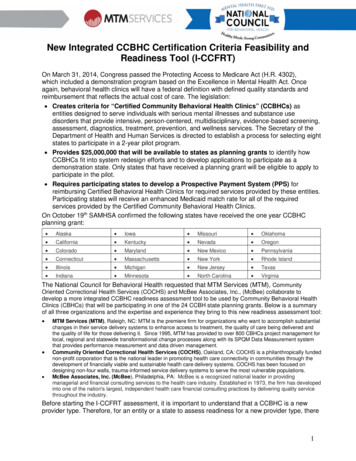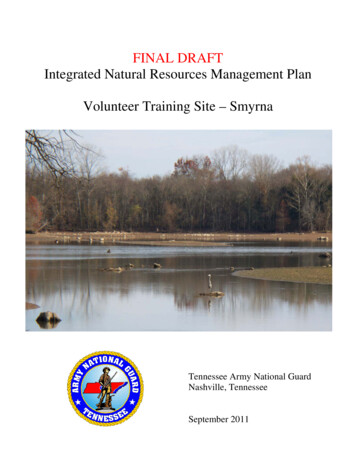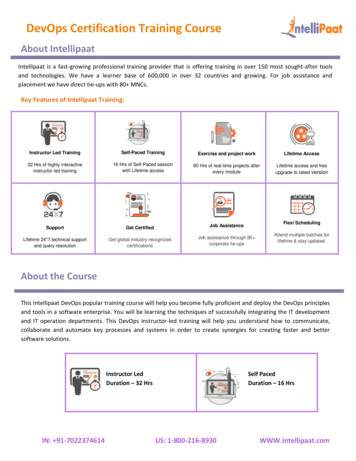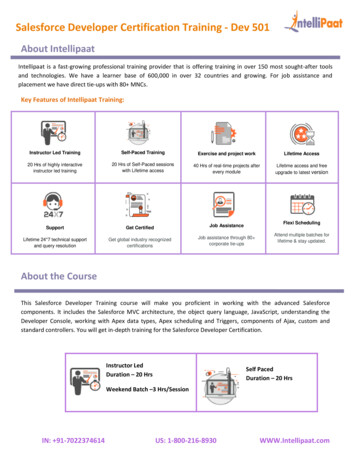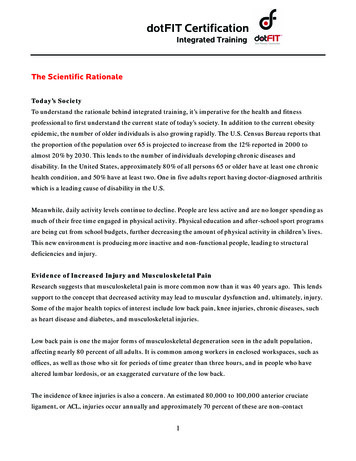
Transcription
dotFIT CertificationIntegrated TrainingThe Scientific RationaleToday’s SocietyTo understand the rationale behind integrated training, it’s imperative for the health and fitnessprofessional to first understand the current state of today’s society. In addition to the current obesityepidemic, the number of older individuals is also growing rapidly. The U.S. Census Bureau reports thatthe proportion of the population over 65 is projected to increase from the 12% reported in 2000 toalmost 20% by 2030. This lends to the number of individuals developing chronic diseases anddisability. In the United States, approximately 80% of all persons 65 or older have at least one chronichealth condition, and 50% have at least two. One in five adults report having doctor-diagnosed arthritiswhich is a leading cause of disability in the U.S.Meanwhile, daily activity levels continue to decline. People are less active and are no longer spending asmuch of their free time engaged in physical activity. Physical education and after-school sport programsare being cut from school budgets, further decreasing the amount of physical activity in children’s lives.This new environment is producing more inactive and non-functional people, leading to structuraldeficiencies and injury.Evidence of Increased Injury and Musculoskeletal PainResearch suggests that musculoskeletal pain is more common now than it was 40 years ago. This lendssupport to the concept that decreased activity may lead to muscular dysfunction and, ultimately, injury.Some of the major health topics of interest include low back pain, knee injuries, chronic diseases, suchas heart disease and diabetes, and musculoskeletal injuries.Low back pain is one the major forms of musculoskeletal degeneration seen in the adult population,affecting nearly 80 percent of all adults. It is common among workers in enclosed workspaces, such asoffices, as well as those who sit for periods of time greater than three hours, and in people who havealtered lumbar lordosis, or an exaggerated curvature of the low back.The incidence of knee injuries is also a concern. An estimated 80,000 to 100,000 anterior cruciateligament, or ACL, injuries occur annually and approximately 70 percent of these are non-contact1
dotFIT CertificationIntegrated Traininginjuries. Non-contact injuries include losing your balance stepping off a curb or planting your foot tochange directions while running. Most ACL injuries occur between 15 and 25 years of age. This comes asno surprise when considering the lack of activity and increased obesity occurring in this age group.Another contributor to musculoskeletal injuries is poor posture, which results in increased neck, midand lower back, shoulder and leg pain.Work-related injuries are also a factor, with over 40% of reported injuries coming in the form of sprainsand strains. More than one-third of all work-related injuries involve the trunk and, of these, over 60%involve the low back. The cost of this poor health and function? The value of lost work time due tomusculoskeletal injuries is estimated to be approximately 120 billion dollars.So what does this all mean? Simply put, the extent to which we condition or decondition ourmusculoskeletal system directly influences our risk of injury. The less conditioned we are, the higher therisk of injury. The body is a master of adaptation. Since our daily lives include little physical activity, weare poorly prepared to participate in recreational and leisure activities such as resistance training,weekend sports or simply playing on the playground. For most, daily life conditions us to handle nomore than sitting still.Traditional Training ProgramsNow that we have a better understanding of today’s client, let’s take a look at how most traditionaltraining programs are designed and how that carries over to the needs of today’s client.First, most traditional training programs do not emphasize movements in all three planes of motionincluding the sagittal, frontal and transverse planes. Most programs include exercises that are primarilysagittal plane dominant, or movements that are performed in a forward and backward motion.Examples of these types of movements include rows, presses and front lunges. Rarely do you seeindividuals performing exercises requiring them to move from side to side in the frontal plane or inrotation in the transverse plane. In fact, many injuries occur while moving in the transverse plane, yettraditional exercise programming does not challenge an individual’s ability to control themselves in thisplane. It will be important that training programs of today challenges the individuals’ ability to controlthemselves in all three planes of motion.2
dotFIT CertificationIntegrated TrainingSecond, the majority of traditional training programs do not emphasize all aspects of the musclecontraction spectrum. Generally, the emphasis is placed on how much weight one can liftconcentrically. Rarely do you see one emphasize how slowly they can eccentrically lower the weightback to the starting position or how well they can isometrically stabilize the load before they lift theweight again. However, most injuries occur during the eccentric and isometric phases of movement.Individuals are typically not trained efficiently to slow themselves down (or decelerate) nor are theyefficient in their ability the dynamically stabilize themselves. This style of training poorly equips theexerciser to handle the dynamic requirements of an active life.For this reason, it is important for programs of today to emphasize all three contractions of the muscleaction spectrum: the concentric contraction, or lifting the load, the eccentric contraction, or loweringthe load, and the isometric contraction to stabilize the body while performing the exercise.Lastly, many traditional programs do not challenge individuals in proprioceptively enrichedenvironment. A proprioceptively enriched environment is one that challenges the internal balance andstabilization mechanisms of the body.Examples of this include performing a dumbbell chest press while on a stability ball or performing anoverhead press on one leg. It is important to include exercises that challenge the internal balance andstabilization mechanisms of the body so they’ll be better prepared to control themselves and protectagainst injury in unstable environments outside the gym. Doing so will also make your clients betterprepared for higher intensity exercise in the future and continuous progress towards their goals.So with all of that said, the new mind-set in fitness should cater to creating programs that addressfunctional capacity, as part of a safe program designed especially for each individual. In other words,training programs must consider each person, their environment and the tasks and activities that theywill be engaged in. This is best achieved by introducing an integrated approach to program design. It isupon this premise that the National Academy of Sports Medicine (NASM) presents the rationale forintegrated training and the Optimum Performance Training (OPT ) model.3
dotFIT CertificationIntegrated TrainingIntegrated Training and the OPT ModelLet’s first define integrated training. Integrated training is a concept that incorporates all forms oftraining in an integrated fashion as part of a progressive system. These forms of training includeflexibility training, cardiorespiratory training, core training, balance training, reactive training, speed,agility and quickness training and resistance training. This system was developed by NASM and istermed Optimum Performance Training (OPT ).The OPT model was conceptualized as a training program for a society that has more physicalstructural imbalances and susceptibility to injury than ever before. It is a process of programming thatsystematically progresses any client to any goal. In other words, it is a periodization system, where eachphase of training prepares the body for the next set of demands.The model is divided into three different building blocks—stabilization, strength and power. Eachbuilding block contains a specific phase or phases of training. It is imperative that the fitnessprofessional understands the scientific rationale behind each building block in order to properly utilizethe OPT model.4
dotFIT CertificationIntegrated TrainingPhase 1 - StabilizationThe OPT model starts with the stabilization level. This level of training consists of one phase of training,stabilization endurance training, with the goals being to increase systemic stabilization, muscularendurance, flexibility and optimum levels of neuromuscular efficiency (control). This level will helpprepare the neuromuscular system for the higher intensities of exercise that will be experienced in thefollowing levels.The progression for this stage of training is proprioceptively based. In other words, rather thanincreasing load, or weight, you increase the stabilization requirements of the exercise. This may come inthe form of performing an exercise from two arms to alternating arms, from two legs to one leg or froma sitting position to a standing position. The loads used at this level are lower with the repetitions beinghigher to enhance endurance.Once an individual has developed appropriate amounts of stability, they can then progress to thestrength level of the model.Strength Level – Three PhasesThe strength level of the model consists of three phases of training: phase 2 strength endurance, phase3 hypertrophy and phase 4 maximal strength.Phase 2 – Strength EnduranceIn phase 2, strength endurance, the training goal is to maintain stabilization endurance whileincreasing prime mover strength. Basically, we are looking to improve the ability to produced higherforces for a longer time. This will enable the body to handle the higher volume and intensity trainingprograms that will come later in the OPT model. These adaptations are accomplished by performing5
dotFIT CertificationIntegrated Trainingtwo exercises in a superset sequence (or back-to-back without rest) with similar joint dynamics for agiven body part. One exercise is a traditional strength exercise performed in a more stable environment,followed immediately by a similar movement performed in a more unstable fashion.For example, one would first perform a chest press on a bench or machine then immediately performsomething like a push up on a stability ball. The principle behind this method is to work the primemovers predominantly in the first exercise in order to elicit prime mover strength. Then, immediatelyfollow with an exercise that challenges the endurance of the stabilization muscles. This produces anincreased ability to maintain postural stabilization or good posture and dynamic joint stabilization.Phase 3 – HypertrophyIn phase 3, hypertrophy, the training goal is to achieve optimum levels of muscular size. To elicitmuscular hypertrophy requires high a level of training intensity and volume. Traditionally, this is wherea lot of individuals begin their training. However, hopefully you can now understand the importancethat one must progress to this level of training to decrease the risk of injury and ensure they attain theirgoal. This phase of training is optional depending on the individual’s goal.Phase 4 – Maximal StrengthIn phase 4, maximal strength, the training goal is to achieve maximal prime mover strength by liftingheavy loads. This form of training increases motor unit recruitment and the frequency of motor unitfiring with peak force production being the end product. Basically, maximal force production,regardless of speed of movement, is the goal. As with phase 3, this phase is optional.Once an individual has obtained optimal levels of strength, they are ready to progress to the Power levelof the model.6
dotFIT CertificationIntegrated TrainingPhase 5 – PowerThe power level consists of one phase of training: Power Training. This level of training emphasizes thedevelopment of speed and power (or rate of force production) while maintaining prime mover strength.In this phase, one would super set a traditional strength exercise with an explosive power exercise ofsimilar joint mechanics. This is to enhance prime mover strength while also improving the rate of forceproduction. An example of training this way would include doing a heavy squat or leg press immediatelyfollowed by jump squats.Individuals would not enter into this level of training until they have developed proper amounts ofstabilization in phase 1 and strength in phases 2, 3, and 4. This will help decrease the risk of injury whileensuring improvements in performance.SummaryIn summary, when working with today’s typical client, who is likely to be deconditioned, fitnessprofessionals must take special consideration when designing programs. An integrated approach shouldbe used to create safe programs that consider functional capacity for each individual. They mustaddress factors such as flexibility, improving stability, increasing strength and endurance, enhancingcardiorespiratory capacity and training in different types of environments. These are the basis forNASM’s OPT model.The OPT ModelThe OPT Model vs. Traditional TrainingThe different periods of training seen in a traditional periodization model include a preparatory period,a hypertrophy period, a maximum strength period and a power period.The OPT model as a phase-specific model of training includes five different phases of training. Thesephases systematically progress all clients through the three main adaptations of stabilization, strengthand power.7
dotFIT CertificationIntegrated TrainingYour client’s exercise programs are based on the OPT model and each component of the workoutincludes a video demonstration. These workouts can be modified based on exercise frequency, durationand available equipment.StabilizationThe first level of training in the OPT model focuses on the main adaptation of
This system was developed by NASM and is termed Optimum Performance Training (OPT ). The OPT model was conceptualized as a training program for a society that has more physical structural imbalances and susceptibility to injury than ever before. It is a process of programming that systematically progresses any client to any goal. In other words, it is a periodization system, where each .


